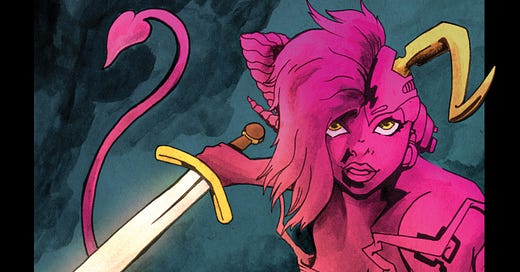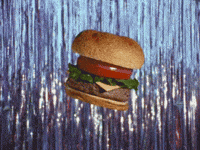I think my artwork is pretty good. Of course, I should be saying, “I think my work is great!” But I’m the artist in this instance and obviously I see my strengths and weaknesses with a clarity only I can see. However, one of the facets that gets in any artist's way, especially when they’re selling artwork, is judging the quality of their artwork on the financial success of the work itself.

I’ve noticed I’ve talked a lot about perseverance and sticktoitiveness in recent weeks. I discuss the value of keeping on keeping on a lot. The last core entries in Fighting the Good Fight covered Patreon, success measurement, the push and pull of content, what to focus on in a career, dealing with censorship, and how to know when you’re leading a project. In each of these I spoke with some authority. I’m not necessarily an expert on nailing it, though. Fighting the Good Fight is not a retrospective on how I made it. I’m not a self-help guru and I’m not here to sell you a path to success. I’m in the trenches, just like you. We’re all fighting our own battle forward and I am recording my experiences in real-time. Hopefully, when I march away with a black eye and some missing teeth, you don’t have to take the same blows because what I said helped you dodge those pitfalls.
While I do my creative work full-time, I’m under no illusion that I am wildly financially successful. I scrape by, and I’d be nowhere without my family and community. I hope that being raw in these entries shows you what I do in action. I’m compelled to share the stories I have because I feel it’s rare for creative folks to rip the bandage off and speak candidly about their experiences. It’s rare, in my opinion, for artists to talk about when a piece is a failure, or when an event is less than successful. We want to show the world how rad we are! We want to shout and celebrate the good, the wins. We’re conditioned by self improvement blogs, social media, and faith-based systems like manifesting, to only project our positives. It looks good. It’s disingenuous.
I aim for raw honesty, and to get closer to that today, I want to break down one of my biggest shortfalls running my artwork as business.
Here’s a side by side of one of my oldest art pieces I've sold as a print, and one I just finished for a client:


The first image, Earthworm Jim, was one the earliest prints I offered. It came out some time after my first shows in which I only carried Champions content. The Earthworm Jim print was also one of my only pieces I ran as a product completely illustrated traditionally. It was a mix of ink washes and alcohol markers. At the time, I loved it. The next piece, tentatively titled Cyber Devil, was created during April 2025. It was drawn from model reference on toned paper, with a watercolor wash and digital colors.
I’m still getting help from Cathryn on crunching all my numbers for the last several years, but I never sold many Earthworm Jim prints. Fan art, as I’ve discussed in the past, isn’t my jam. I don’t have the best time working on it, and I am not the most excited to talk about it. Earthworm Jim — as a character — was a big part of my creative upbringing. So, of course I liked Jim. But I’m more about creating new things inspired by the things I love. When it came to shows, the few people that recognized Earthworm Jim would point, talk about the games or the cartoon, and on at least one occasion, show me their Jim tattoo. But it didn’t sell.
Maybe my take on Jim was too literal? Maybe my ink washing wasn’t very strong? I’d just gotten into washes at that point. And, worst of all, maybe my work just wasn’t any good?
I’m not sure I’ll ever really know. I don’t run the Earthworm Jim print anymore. I moved on, and my artwork did, too. However the concern about my creative work, its value, and my value stuck with me. If no one buys something, it must not be that good.
Flash forward to now. My client, Excalibur Con, has accepted Cyber Devil. It’ll be featured on badges at Excalibur Con this fall! I made original art, with an original character, illustrated from model reference, just like I like it. It’s even got print potential. I plan to run it as a print for the event and see how it performs. My expectations aren’t through the roof, though. My original work moves slowly. Sometimes gruelingly. That snail’s pace can let the internal criticism back in easily. It’s a constant fight to remind myself that my self-worth has little to do with my art, and that my art has improved and evolved in so many ways. Sure, there’s some common DNA between my Earthworm Jim print and the Cyber Devil piece. But I, and my work, have come a long way. What truly makes these pieces similar is that they have narrow appeal.
Want to see a deep dive on how Cyber Devil developed? It’s on Patreon!
If we agree that I’ve improved, and we agree that most of the artistic flaws and shortcomings that I perceive are in my head, great! Why, then, do I not have incredible sales all the time?
The first thing we need to accept is that sometimes we just have a bad show. It happens. There’s not much that can be done in those situations. We can analyze our table placement, or displays, the weather, and competing events. But, sometimes it’s just a bum gig.
Sometimes it’s not a bum gig and we just don’t meet our expectations. For me, I know that fandom shows are tough. I love them because of the relationship I have with the shows, the showrunners, and parts of the crowd. But, I’m not a fandom guy. And, more critically, my work doesn’t have broad appeal. Lacking broad appeal isn’t a bad thing! It just makes nailing sales trickier.
Items with broad appeal are like a cheeseburger. Everyone buys a cheeseburger almost all the time. If your work is sweepingly general or hits people’s nostalgia, or what’s hot, and maybe uses a different cheese (in this instance a color technique or line technique), you’ll probably have predictable sales and generally sought after content.
Work with narrow appeal might come off like a can of sardines. As someone who’s eaten a can of sardines in a crowded breakroom, it’s not everyone’s thing. But, that doesn’t mean sardine lovers aren’t out there! I’ve eaten them, and they’re on store shelves, so there must be people who want them. The ultimate question is: where do we go to find those sardine lovers? Where are the people who want what I want and will buy what I make?
I think most artists who struggle to build an audience aren’t artistic failures. I don’t think they’re hacks with bad work. I think they, like me, get caught up in trying to appeal to a broad audience, trying to shoehorn themselves into the shape of a cheeseburger when they’re not. Or, they aren’t sure why their sardines aren’t selling at the cheeseburger stand. This is something I struggle with almost constantly because I want to be where the cheeseburgers are, and I want my sardines to sell just like cheeseburgers, time after time.
Let’s get lost in the weeds of this metaphor. Sardines, if you like them, rock. If you’re trying to sell sardines, you have to remember that they rock, and that their buyers are special. The sardine enthusiast isn’t like everyone else. The sardine enthusiast has refined taste. They’ve grown bored with the cheeseburgers, or perhaps they’ve always known what they really want. And, as hard as it is to sell sardines at a cheeseburger stand, the sardine enthusiast doesn’t find them everywhere. These enthusiasts are excited when they see sardines, but they don’t expect to see them around every corner.
Narrow appeal artwork needs to be treated exactly the same way. I think it needs to be loud and proud about what sets it apart. I believe that any artist focusing on something more niche ought to do everything in their power to embrace that niche as fully as they possibly can. Embracing what sets them apart might mean pursuing different events, finding different cities or audiences, or being so obviously niche that anyone looking knows exactly what they’re seeing.
Defining our work is necessary for knowing its appeal. My work is primarily figurative, nearly explicitly depicting feminine forms. It’s often rich in ink work and showcases careful, studied linework. The work I like making the most is dark, or moody. At my best I show a realism in fantasy that telegraphs confidence and struggle. I create work from a faithless perspective, and often evoke challenging concepts. I sell mostly to LGBTQ+ folks, the bulk of whom identify as feminine or women. The artwork I produce is mature and vastly original. It’s good work, and my customers have good taste.
If I can distill that down into as few words as possible, I’ll know exactly who my work is for. Regardless of how I land on simplifying all of that, I have to remember that my work and my customers exhibit refined taste. They’re exceptional, but not built for mass appeal. The niche I find myself in is the best niche because it’s our niche: mine and my customers.
Right now, Cathryn is helping me distill down all my sales for the last five years. We’re trying to stab at what shows serve me best, and what pieces are selling well compared to what I want to make. The results of this distilling might lead to some shows dropping off my calendar, while tightening my focus on what regions seem to have my niche in it. In the end, I should also have a better understanding of what was working while I was growing as an artist.
I don’t anticipate changing my relationship to every fandom show, although fandom shows are cheeseburger shows. Some might fall off my radar, sure. But, with the value Dylan’s Drink & Draw offers me and the show, I’m not cutting that off. I will, however, take this time to remind myself that I am offering a can of sardines amidst a sea of cheeseburgers. I cannot waste more time trying to force myself to look like a cheeseburger, smell like a cheeseburger, or taste like a cheeseburger. I am not a cheeseburger. If I am going to offer my refined, and exceptional niche, I need it to be such an obvious niche that a cheeseburger fan might just try these sardines.










I was wondering what that piece was for!